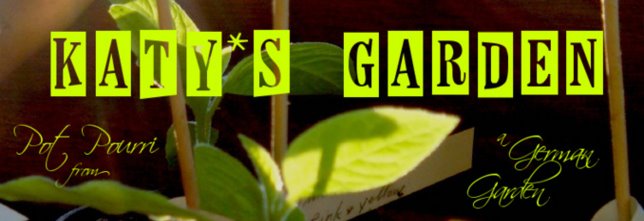Third day on the meadow with hubby, trying to sort out the huge wood pile we inherited from the butchery of every single tree that provided a bit of wind shelter to the garden (I am calm, no I am really very calm, shredding twigs, cracking boughs and extracting long heavy chunks of tree out of the pile is a fantastic way to vent aggression). It is like trying to sort out a mikado 2 m high, 8 m long and 4 m wide, where every stick is crooked or forked, the ground is slippery with rotten bark and Fallopia baldschuanica has tied a final knot on the packet. Amazinly enough, it's fun, if a bit overwhelming. The shredded twigs are a wondefully nice tactile material, even better than shredded bark from the GC and the first lot, mixed with grass clippings, is already hot in the compost heap. It will be a great material to mix with greens in the compost. I am looking forward to the lovely smooth black stuff that will soon result. Three days of work, perhaps we managed one third of the pile. One cubic m of shredded bits, and a huge pile (not much smaller than the original one, for some reason) of larger branches to be dried and broken for firewood.
I really love my compost heaps. I love composting a lot, I cannot understand gardeners that do not compost at all. I even had a heap in the old miniature little garden.
I love the physical work involved, turning it over with the fork again and again, airing it, keeping it fluffy and sweet. I love the careful composition, somewhat close to cooking, greens and browns, wets and dryes, nitrogen, air, water. You can feel it live, and the ground with it, afterwards. I didn't always understand this quote in one of my favourite garden quotes books:
"I find that a real gardener is not a man who cultivates flowers; he is a man who cultivates the soil. He is a creature who digs himself into the earth and leaves the sight of what is on it to usgaping good-for-nothings. He lives buried in the ground. Hebuilds his monument in a heap of compost. If he came into theGarden of Eden, he would sniff excitedly and say: "Good Lord, what humus!"- Karel Capek, The Gardener's Year, 1931
I was too green (but not yet green fingered enough) to appreciate this truth. You need to make a garden on heavy clay before you get so obsessed with humus. I am now, but in a very pleasurable way. I delight in the process of improving the ground.
"L'orto di un perdigiorno" by Pia Pera is a wonderfully inspiring book in that sense. I am not saying the the book is more educative than other gardening books I have read. But it has a poesy, and a livelyness to it that put the heavy chores of gardening in a different perspective. It had a leavening power for me. It touched me, and my way to conceive the garden, and changed it. It is a great debt. I have met Pia Pera, twice and briefly, a very intriguing lady, naturally graceful, delightfully soft spoken. It came as a surprise to me when I searched for her books on Amazon and I stumbled on the scandal of "Lo's Diary", another of her book, quite a different story. I have known her in such a different light, but I rejoice in the surprise. I like lady gardeners with some intrigue in their history.
Subscribe to:
Post Comments (Atom)


No comments:
Post a Comment